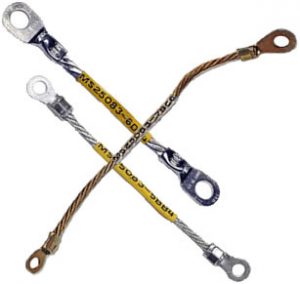 When shopping for electrical components to use in an airplane, you may come across bonding jumpers. They are commonly used in most private and commercial airplanes.
When shopping for electrical components to use in an airplane, you may come across bonding jumpers. They are commonly used in most private and commercial airplanes.
As shown in the adjacent photo, bonding jumpers feature a simple design consisting of woven metal fibers with a connector on each end. How are bonding jumpers used in airplanes exactly?
What Are Bonding Jumpers?
Also known as bonding cables, bonding jumpers are conductive connectors that are designed to create a safe pathway for electricity. Electricity, of course, travels through conductive objects. It will always take the path of least resistance.
Conductive objects are characterized by their minimally resistive properties, so electricity will typically travel through them. Bonding jumpers are essentially conductive cables that safely direct electricity from one place to another place. When placed near a source of electricity, bonding jumpers will create a safe pathway for it.
How Bonding Jumpers Are Used in Airplanes
Bonding jumpers are typically used as grounding solutions in airplanes. Excess or stray electricity can cause shocks. With electricity jumps from one device to another device, for instance, it may cause a shock. Fortunately, grounding solutions prevent this from happening.
Electrical systems and devices can be grounded in different ways. In homes and buildings, grounding solutions often consist of conductive cables that are connected directly to the ground. The ground has a negative electrical charge. Therefore, it attracts positive electrical charges. Airplanes, however, require a different grounding solution.
Airplanes can’t be connected to the ground, so they typically use bonding jumpers, instead. Bonding jumpers create a safe pathway for electricity. They are used in places where there’s an inherent risk of a stray electrical charge. Hinges and bearings can create stray electrical charges. When hinges and bearings move, they’ll generate friction. This friction can create static electricity.
Bonding jumpers can prevent the buildup of static electricity between hinges, bearings and other moving parts. Once installed, they’ll create a conductive pathway. Static electricity will travel through the bonding jumpers rather than entering the surrounding space. All bonding jumpers are conductive. And like other conductive objects, electricity will travel through them with little or no resistance.
In Conclusion
Bonding jumpers are conductive cables that act as grounding solutions in airplanes. They are made of conductive metal, and they feature a connector on each end. In airplanes, bonding jumpers are designed to attract electricity so that it can be safely routed.



